- Mimosa aculeaticarpa var. biuncifera
-
Catclaw mimosa 
Seeds of catclaw mimosa Scientific classification Kingdom: Plantae (unranked): Angiosperms (unranked): Eudicots (unranked): Rosids Order: Fabales Family: Fabaceae Subfamily: Mimosoideae Genus: Mimosa Species: M. aculeaticarpa Binomial name Mimosa aculeaticarpa var. biuncifera
OrtegaSynonyms - M. biuncifera Benth.
- M. biuncifera Benth. var. glabrescens A. Gray
- M. biuncifera Benth. var. lindheimeri (A. Gray) B.L. Rob.
- M. lindheimeri A. Gray
- M. warnockii B.L. Turner
- Mimosopsis biuncifera (Benth.) Britton & Rose
Mimosa aculeaticarpa var. biuncifera is a shrub in the Fabaceae family. It is commonly known as the catclaw mimosa or the wait-a-minute bush and is endemic to upland regions of Mexico, Arizona, New Mexico and Texas.[1] This species used to be classified as Mimosa biuncifera but it was found that phenotypic variations occurred across its range and a new taxonomy was proposed by Rupert C. Barneby in 1986, splitting the species into Mimosa aculeaticarpa var. biuncifera and Mimosa texana.[2]
Contents
Description
The catclaw mimosa is a straggling thicket forming shrub, usually growing to about one metre tall but occasionally double that height. The twigs are hairy and armed with backward pointing spines that easily catch in clothing. The alternate leaves are bi-pinnate with a varying number of small oblong leaflets. The flowers are white or pale pink, bunched together in globular heads. The fruits are flat pods up to four centimetres long, flattened between the seeds and splitting open when ripe. There are recurved prickles on the edges of the pods.[3][4]
Distribution
This species grows in upland areas of central and southern Arizona, southern New Mexico, western and central Texas and northern Mexico.[3]
Ecology
This species occurs as scattered individual plants in oak, oak-pine, and evergreen woodlands, pinyon-juniper woodland and mixed with other shrubs in grassland and shrub-steppe communities. It grows on mesas, rocky slopes and gravel deposits. It is commonly found growing in chaparral and is spreading into desert and semi arid areas. This may be because the seed pods are eaten by cattle and the seeds are deposited in the dung, giving them a rich environment for germination. The plant is fire tolerant and sprouts readily after bushfires.[3] In upland areas of west Texas, the redberry juniper (Juniperus pinchotii) acts as a nurse plant for the seedlings. They benefit from the shade and leaf litter associated with the juniper which seems to provide a favourable microclimate for the establishment of the seedlings.[5]
References
- ^ USDA
- ^ Re-evaluation of Mimosa biuncifera and M. texana (Leguminosae: Mimosoideae)
- ^ a b c US Forest Service: Fire Ecology
- ^ Lady Bird Johnson Wildflower Center
- ^ Medina, Alvin L. 1987. Woodland communities and soils of Fort Bayard, southwestern New Mexico. Journal of the Arizona-Nevada Academy of Science. 21: 99-112. [3978]
Categories: Mimosa
Wikimedia Foundation. 2010.
